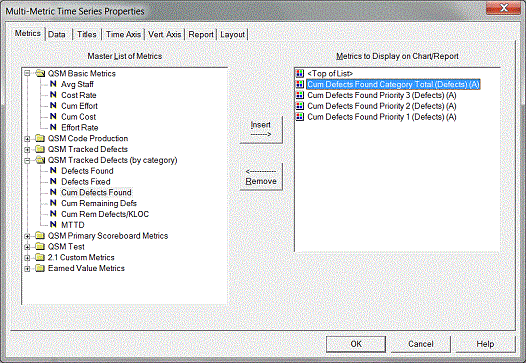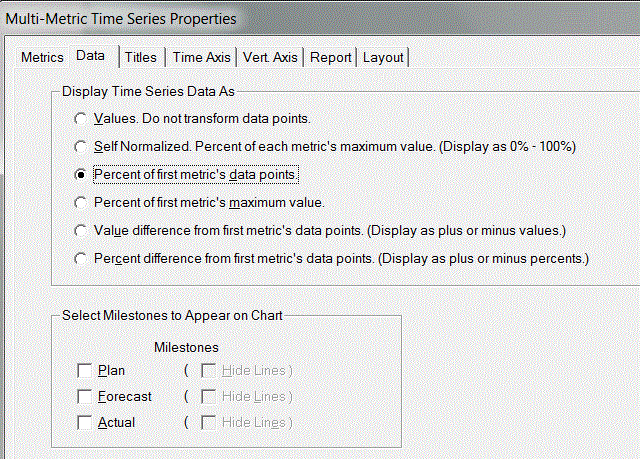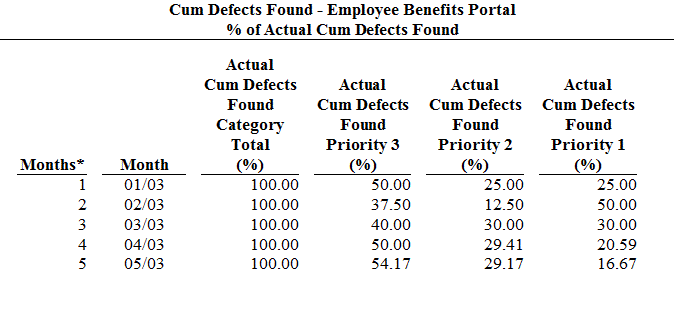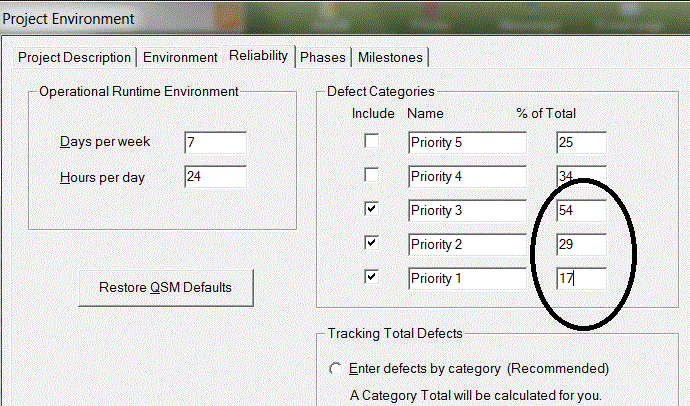- Home
- Frequently Asked Questions
- <GENERAL FAQ>
- Charts & Reports
- Frequently Asked Questions - Charts & Reports
Frequently Asked Questions - Charts & Reports
View the Reports and Graphs Export Table to see the best way to get SLIM-Suite reports and graphs into other applications.
There's a good fit between my total defect data and the plan but in the defects by category charts, the defect actuals for each category aren't tracking the plan very well. How can I fix this?
Chances are your defect category percentages need to be adjusted. To tune these percentages using your actual data, create a Multi-Metric Time Series Chart and insert a QSM Tracked Defects Category Total (Actual) metric for each defect category you're tracking:

Next, right click on your chart to access the chart property tabs. On the Data tab, select "Percent of first metric's data points" and click OK to exit the dialog.

Next, toggle your Multi-Metric chart into report form:

If the weekly or monthly values seem fairly consistent, you can simply use the latest % of total for each category. If you see a lot of variation, you may want to average the values - don't be afraid to experiment until you get the best visual fit! Enter the % for each category on the Reliability tab of the Project Environment dialog:

Once you return to the defects by category views, you should see a better fit between the plan and actuals.
My actual defect data points don't show up on the defect remaining and defect remaining/sloc reports and graphs. Why not?
Before we can calculate and display the number of errors remaining, we must know the forecasted number of errors in the system. Planned defects remaining is the difference between planned total defects and planned defects found at various points in time. Actual defects remaining are calculated by subtracting actual defects found from the forecasted total defects.
Therefore, the actual number of defects remaining will be shown only when a forecast exists.
The Solution Panel says my peak staff value is 10.3, but the Average Staffing Rate charts and reports show a peak staff of 10.1. What is causing this inconsistency?
The theoretical Rayleigh curve used to derive the values on the Solution Panel is a smooth curve resulting in different staffing numbers at each point along the x-axis. In drawing the Average Staffing chart, this smooth theoretical curve is approximated by a series of discrete staffing rates (with one bar, or average staffing rate value, per month).
The graph and solution panel values won't always match exactly because the graphical peak staff is always taken mid-month for any internal month while the solution panel always shows the highest peak staff point on the staffing curve (regardless of when it occurs). Usually the theoretical curve does not peak exactly at mid-month, so the true peak shown on the solution panel will not match the one on the average staffing charts unless the theoretical peak happens to fall at mid-month.
On large projects where a longer schedule allows a natural smoothing of the staffing curve, the theoretical peak staff will usually be close to the average staff rate value. On shorter projects, you can expect to see larger discrepancies.
When I change the Person Hours per Person Month field in Accounting Options, there is no change to the total schedule and effort for the project. How can I adjust the estimate to reflect overtime?
The person hours/person month field was never intended to be used for performing time/effort tradeoffs. For estimating purposes, SLIM-Estimate assumes that a FTE person is a FTE person, regardless of the number of hours in an effort month. To account for overtime or unusual staffing situations, you should adjust the FTE (full-time equivalent) peak staffing level.
For example, to reflect 10% overtime, you need a peak staff that is 1.1 times the current peak. You can do this using the Control Panel peak staffing dial or by extending or shortening the Phase 3 schedule.
NOTE: if you are using a PI from your completed projects, you should only make this type of adjustment if your history does not include overtime. It is usually better to be conservative in making adjustments as overtime hours are often less productive. If the completed projects you used to derive a PI had a similar amount of overtime, it is already reflected in the PI and no adjustment is needed.
Sometimes the effort data points on my Life Cycle Sensitivity to PI graph have values that do not always increase (or decrease); e.g., there are small dips in the data.
Remember that the time and effort shown on these graphs are life cycle values. The most likely cause of slight variations in the expected behavior of the data is caused by variation in the effort for phase 4. Staffing projections for phase 4 are dependent on the staffing rate at the end of phase 3. Therefore, differences in the final phase 3 staffing rate can result in variations in the total effort for phase 4. You can check to see if this is the case by making the solutions in question the current solution, then comparing the phase 4 effort in the solution panel of the staffing view.
What is the impact of selecting various phase staffing shapes? When should I deviate from the default Rayleigh pattern, and how is my estimate affected?
We have found that the default Rayleigh pattern is the staffing pattern that best matches the application of effort to the work to be performed but due to staffing constraints or different software management styles, you may decide that another staffing pattern fits your organization or project better.
In general, the various staffing shapes can be described as follows:
- Front Load Rayleigh peaks at approximately 40% the phase
- Medium Front Load Rayleigh peaks midway through the phase
- Medium Rear Load Rayleigh peaks at approximately 75% of the phase
- Rear Load Rayleigh (Phase 3 only) peaks at the end of the phase
- Level Load maintains a constant staffing level over the entire phase
- Exponential (Phase 4 only) gives the most rapid drop off of staffing from the end of Phase 3.
- Stair Step (Phase 4 only) begins at about half of the staffing level from the end of Phase 3 and stair steps down.
- Straight Line: (Phase 4 only) represents a straight-line decrease in staffing from the end of Phase 3.
- Rayleigh (Phase 4 only) is a natural tailing off/continuation of any Phase 3 Rayleigh curve. Not valid if the selected Phase 3 staffing shape is Level Load.
Level loading is generally seen in the development of very small systems. In larger systems, early application of people often represents wasted effort. The Default Rayleigh shape determines the staffing shape based on the size of the application. QSM has found that small projects (less than 18,000 lines of code) tend to have a Front Load Rayleigh profile while larger systems (greater than 100,000 lines of code) typically reach peak staffing towards the end of phase 3. For very small systems (3 to 6 months in duration with a peak staff of 1-3 persons), a level load profile is more appropriate.
The estimated total effort for each of the staffing patterns for the first three phases will remain constant regardless of the pattern selected. Phase 4 effort will vary, depending on the shape of phase 3. This is because in phase 4, manpower tails off from the final Phase 3 staffing level and is therefore a function of the number of people on board at the end of phase 3 and the length of phase 4. Projects that peak at the end of Phase 3 will have higher phase 4 effort. Projects that peak earlier will have lower phase 4 effort.
If you are using default QSM overlaps for the phases, you can expect to see some differences in the phase overlap when you change the staffing pattern. This occurs because SLIM attempts to produce the smoothest aggregate staffing pattern when moving from one phase to the next.
For example, the overlap percentage between Phases 2 and 3 will be 0% if Phase 3 is Level Loaded. Otherwise the overlap ratio will range from 33% to 40% as the phase 2 staffing shape changes from Front Load Rayleigh to Medium Front Load Rayleigh.
Is there a limit on the number of projects that can be loaded into SLIM-MasterPlan?
There is no limit to the number of projects you can load into MasterPlan other than what is allowed by the graphics and memory capabilities of your PC. But if your MasterPlan workbook includes an unusually large number of projects it may be difficult to see all the projects clearly on graphs.
Here are some suggestions for MasterPlan files with a large number of projects:
- Place a single graph on each view to allow more room for MasterPlan to display the projects onscreen.
- Use the Level of Detail tab in Gantt Chart Properties to adjust the number of levels shown
- Group your projects by category, perhaps by division, year, budget, or program to make your MasterPlan estimates more meaningful
- Consider moving projects which are more similar to iterations to SLIM-Estimate as a Work Breakdown Structure (WBS)
